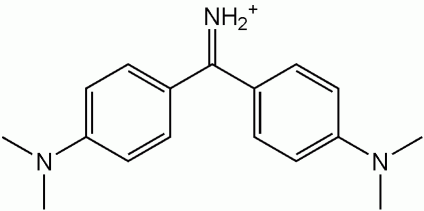Auramine O
| Template:Chembox header| Auramine O | |
|---|---|

| |
| Systematic name | Auramine O |
| Chemical formula | C17H22N3Cl |
| Molecular mass | 303.8339 g/mol |
| Density | x.xxx g/cm3 |
| Melting point | 267 °C |
| Boiling point | xx.x °C |
| CAS number | [2465-27-2] |
| SMILES | [NH2+]=C (C2=CC=C (N(C)C)C=C2) C1=CC=C(N (C)C)C=C1 |
| Template:Chembox header | Disclaimer and references | |
Auramine O, also called Basic yellow 2, Pyocatanium aureum, aizen auramine, Pyoktanin Yellow, Canary Yellow, Pyoktanin, or C.I. 41000, is a diarylmethane dye used as a fluorescent stain. In its pure form, Auramine O appears as yellow needle crystals. It is very soluble in water and soluble in ethanol.
Auramine O can be used to stain acid-fast bacteria (e.g. Mycobacterium), where it binds to the mycolic acid in its cell wall) in a way similar to Ziehl-Neelsen stain.[1] It can also be used as a fluorescent version of Schiff reagent.[2]
Auramine O can be used together with Rhodamine B as the Truant auramine-rhodamine stain for Mycobacterium tuberculosis.[3][4] It can be also used as an antiseptic agent.
Safety
Its risk and safety phrases are Template:R22 Template:R24 Template:R40 Template:S36/37 Template:S45.
References
- ↑ Kommareddi S, Abramowsky C, Swinehart G, Hrabak L (1984). "Nontuberculous mycobacterial infections: comparison of the fluorescent auramine-O and Ziehl-Neelsen techniques in tissue diagnosis". Hum Pathol. 15 (11): 1085–9. PMID 6208117.
- ↑ Khavkin T, Kudryavtseva M, Dragunskaya E, Polotsky Y, Kudryavtsev B (1980). "Fluorescent PAS-reaction study of the epithelium of normal rabbit ileum and after challenge with enterotoxigenic Escherichia coli". Gastroenterology. 78 (4): 782–90. PMID 6986320.
- ↑ Truant J, Brett W, Thomas W (1962). "Fluorescence microscopy of tubercle bacilli stained with auramine and rhodamine". Henry Ford Hosp Med Bull. 10: 287–96. PMID 13922644.
- ↑ Arrowood M, Sterling C (1989). "Comparison of conventional staining methods and monoclonal antibody-based methods for Cryptosporidium oocyst detection". J Clin Microbiol. 27 (7): 1490–5. PMID 2475523.